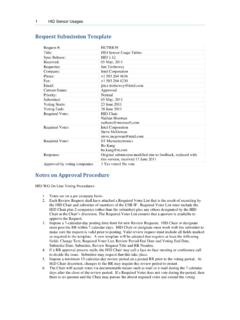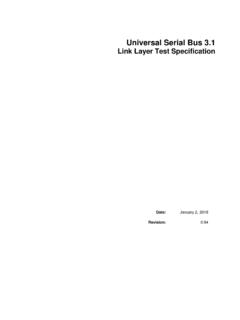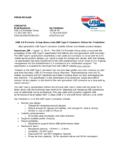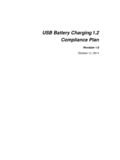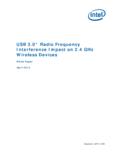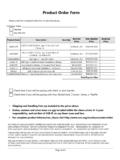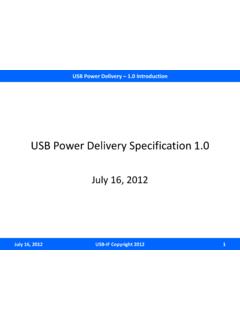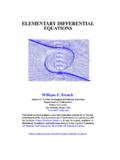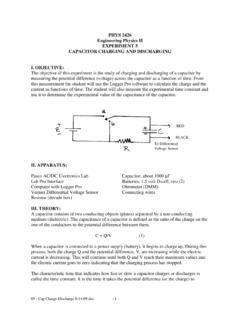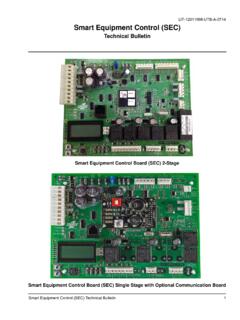Transcription of USB Type-C® System Overview
1 USB Implementers Forum 2019 USB Implementers Forum 2019 Enabling connections for data, display and powerBrad Saunders Co-Chair, USB Type-C Working GroupUSB Developer Days 2019 Taipei, TaiwanNovember 19, 2019 USB Type-C System OverviewUSB Type-C , USB-C and USB4 are trademarks of the Universal Serial Bus Implementers Forum (USB-IF). Thunderbolt is a trademark of Intel Corporation. All product names are trademarks, registered trademarks, or service marks of their respective Implementers Forum 20192 USB Power DeliveryUSB Type-C Cable & ConnectorUSB , USB and USB4 Robust, slim connector with reversible plug orientation and cable directionDelivers up to 40 Gbps supporting all of your data transfer and display needsDelivers up to 100W power and charging for all your devicesPerformancePowerConvenienceUSB Implementers Forum 2019 USB4 Extending USB on Multiple Vectors Enables the next generation of USB performance over existing USB Type-C cable plug/wires Doubles performance and extends protocol to display and load/store applications New signaling rates and encoding for use on existing cables Gen2 (10 Gbps) works over all existing full-featured cables including Gen1 cables Gen3 (20 Gbps)
2 Requires higher performance Gen3 cables USB4 builds on USB Enhanced SuperSpeed USB tunnelingon a new USB4-specific transport DisplayPort and PCIe supportedvia separate tunnels with configurablebandwidth management USB4 discovery and entry relies on USB PD protocol USB4 power requires a USB PD Explicit Contract3 Dual-lane operationfor 20 Gbps and 40 GbpsLane 0 Lane 1 View into the plugUSB Implementers Forum 20194 Presentation Agenda USB Type-C Fundamentals Delivering Power USB4 Power Requirements USB4 Discovery and Entry Device and Cable Discovery/Entry USB4 Hub connectionsUSB Implementers Forum 2019 USB Type-C Summary CharacteristicsMechanical specifications 24-pin receptacle ~ mm x ~ mm 10,000 cycle durability Flip-able, reversible plugs/cables Standard USB4 / USB / USB cables and Legacy Adapters Improved EMI/RFI mitigation features Current ratings: 3 A for standard cables 5 A for connectorsFunctional capabilities USB : LS/FS/HS USB : Gen1 (5 Gbps) / Gen2 (10 Gbps) USB4 : Gen2 (10 Gbps) / Gen3 (20 Gbps) x 2 Electronically-Marked Cables enabled via USB PD Alternate Mode capabilities enabled via USB PD Enhanced power options.
3 Extended 5 V current ranges plus USB PDOriginal rendering courtesy of Foxconn5 USB Implementers Forum 2019 USB Implementers Forum 2019 USB Type-C Specification Release Referenced Specifications USB Specification USB Specification USB4 Specification, Version USB Power Delivery Specification, Revision ( ) DisplayPort Alt Mode, Version Informative functional Requirements Connector and cable definitions Electro-mechanical performance requirements (USB4 Gen3 added) Requirements Pin and signal requirements Configuration channel requirements Power Discovery and Entry USB4-specific product functional and power requirements Cable discovery and entry Host, hub and device discovery and Cables Currently only covers up to USB USB4 update in work, expected later this Adapter Accessory Accessory Type-C Digital Cable Thermal Modes relocated from Chap 3 Compatibility Discovery and EntryUSB Implementers Forum 2019 USB Type-C Signal Summary7 Signal GroupSignalDescriptionUSB / USB4 TXp1, TXn1 RXp1, RXn1 TXp2, TXn2 RXp2, RXn2 SuperSpeed USB / USB4serial data interface.
4 One transmit diff pair and one receive diff pair per laneTwopin sets to enable x2 operationUSB , Dn1Dp2, Dn2 USB serial data interfaceTwopin sets, one wire set to enable plug flippingConfigurationCC1, CC2(receptacle)CC(plug)CC channel in the plug used for connection detect,interface configuration, and USB PD commchannelAuxiliary signals SBU1, SBU2 Sideband Use; SBTX / SBRX for USB4 operationPowerVBUSUSB bus powerVCONN(plug)USB plug power fromSource via the unused CC1 or CC2 receptacle pinGNDUSB cable return current pathUSB Implementers Forum 2019 USB Type-C Configuration Channel (CC) Detect attach of USB ports Establish Source and Sink roles between two attached ports Initially synonymous with Host and Device roles Discover and configure VBUS Discover and configure VCONN Resolve cable orientation and twist connections to establish USB data bus routing Also establishes Lane 0 for USB and USB4 Discover and enter USB4 operation using USB PD protocol Discover and configure optional Alternate and Accessory modes using USB PD protocol8 USB Implementers Forum 2019 USB Type-C Functional Model USB / USB4 data bus Two sets of TX/RX pin pairs, supports x1 and x2 operation USB data bus Two pin sets on host.
5 One set on device strapped together within the host and device Two power buses VBUSand VCONN Two sideband pins (SBU1/SBU2) SBTX / SBRX for USB4 CC Configuration Channel Two CC pins in connector One CC wire in cableLooking into the cable or product plug:Looking into the product receptacle:9 Lane 0 Lane 1 USB Implementers Forum 2019 USB Type-C Functional Model USB Type-C Full-Featured Cable supports all USB operating modes10TX2RX2TX1RX1CC2 USB D+/ CC1CC Logic & VCONNS witchSBTX/SBRXHost USBTX2RX2TX1RX1CC2 USB D+/ Device USBUSB Type-C Full-Featured Cable1 USB Type-C PlugsCC1CC wireCC LogicSBTX/SBRXNote: VBUSand Ground wires not shown in this illustration Lane 0 Lane 1 USB Implementers Forum 2019 Understanding USB Type-C port behaviors Power roles: Source typical of host or hub downstream ports Sink typical of device upstream ports Dual-Role Power (DRP) can be either a Source or a Sink hosts typically moving to here Data roles.
6 DFP-mode only typical of host or hub downstream ports UFP-mode only typical of device upstream ports Dual-Role Data typical of on-the-go ports hosts typically moving to here Roles can be dynamically swapped using USB PD Power role swap, data role swap, VCONN swap11 USB Implementers Forum 2019 USB Type-C Pull-Up/Pull-Down CC Model Host side can substitute current sources for Rp Powered cables and accessories introduce Ra at the unwired CC pins which are used to indicate the need for VCONN12 USB Implementers Forum 2019 Basic USB Type-C System Implementation Model13 Embedded ControllerUSB Type-C Port ManagerUSB Data PortUSB Type-C/PD Port ControllerHS MuxPort TerminationPower SourcePower SinkPMICAlt Mode InterfaceReceptacleUSB4 / USB , SBU1/2 VBUS.
7 GNDVCONNSBU1/2I2 CProduct FunctionalUCSIUSB4 Data PortSBU MuxUSB Implementers Forum 2019 SBU MuxData Bus Interface Implementation14 Embedded ControllerUSB Type-C Port ManagerUSB Type-C Port/PD ControllerPort TerminationPower SourcePower SinkPMICR eceptacleCC1/2, SBU1/2 VBUS, GNDVCONNSBU1/2I2 CUCSIUSB Data PortHS MuxAlt Mode InterfaceProduct FunctionalUSB4 Data PortUSB4 / USB implementation choices depending on interfaces supported USB generally sourced by host and device functional silicon Similar with Alt Mode functional buses High-speed mux can be either integrated or discreteUSB Implementers Forum 2019 USB Type-C Port Controller15 USB Data PortHS MuxPort TerminationPower SourcePower SinkPMICAlt Mode InterfaceReceptacleUSB4 / USB , SBU1/2 VBUS.
8 GNDVCONNSBU1/2 Product FunctionalUSB4 Data PortSBU MuxEmbedded ControllerUSB Type-C Port ManagerUSB Type-C/PD Port ControllerI2 CUCSIUSB Type-C Port Controller Port Power Control for VBUSand VCONN USB Power Delivery PHY CC Logic FunctionPort Manager and Controller collectively implement the USB Type-C State Machines and USB Power DeliveryUSB Type-C Port Manager Port Policy Engine USB Power Delivery Protocol Interface to System software via UCSIUSB Implementers Forum 201916 Presentation Agenda USB Type-C Fundamentals Delivering Power USB4 Power Requirements USB4 Discovery and Entry Device and Cable Discovery/Entry USB4 Hub connectionsUSB Implementers Forum 2019 USB Type-C Power All solutions required to support Default USB Power appropriate to product as defined by USB , USB and USB4 (as defined in the USB Type-C spec)17 PrecedenceMode of OperationNominal VoltageMaximum CurrentHighestUSB PD (including USB4)
9 Configurable5 A USB Type-C Current @ A5 AUSB Type-C Current @ A5 AUSB BC VUp to ADefault USB PowerUSB x2 operation5 V1,500mA*USB x1 operation5 V900 mA*LowestUSB V500 mA**Current available depends on device and bus operating state, unconfigured, low power, high power, Implementers Forum 2019 USB4 Power Requirements USB4 operation requires VBUS power provided using a USB PD Explicit Contract USB4 Source Power Requirements: minimally provide W (5 V @ A) on each port USB4 Sink Power Requirements Devices allowed only up to 250 mA on VBUS when the Source advertises Default USB power prior to establishing a PD Explicit Contract Devices have to be capable of operating with a Source that only delivers W Higher levels of performance / functionality can require more power Device Suspend Behavior Devices are required to support Suspend when the USB4 link is in the disabled state (CLd) with the USB Suspend Supported Flag set by the Source Suspend power limits: Device not capable of remote wake or not enabled for remote wake.
10 25 mW Device supports and is enabled for remote wake: 50 mW VCONNS ource requirement remain W18 USB Implementers Forum 201919 Presentation Agenda USB Type-C Fundamentals Delivering Power USB4 Power Requirements USB4 Discovery and Entry Device and Cable Discovery/Entry USB4 Hub connectionsUSB Implementers Forum 201920 USB4 Discovery and Entry USB Type-C functionally defaults to USB and USB if no additional functiona

